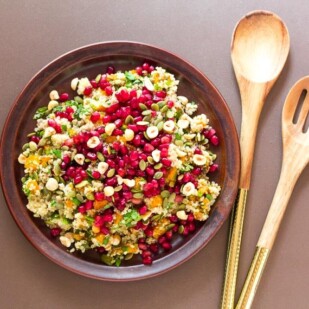
Low FODMAP Roasted Pumpkin Quinoa Salad
Our Low FODMAP Roasted Pumpkin Quinoa Salad is hearty enough for a main dish at lunch, or add a small amount of roasted meat, chicken, fish or tofu for dinner. Japanese pumpkin, also known as kabocha squash and Kent pumpkin, contains No FODMAPs and quinoa is low FODMAP, protein-packed and easy to cook. Combined with fresh herbs and nuts and fresh, juicy pomegranate seeds, this is a memorable salad. Company worthy.
Low FODMAP Serving Size Info: This salad can serve 6 as a side dish or 4 as a main lunch dish.
Ingredients:
Roasted Pumpkin:
- 1- pound (455 g or about 4 cups) cubed kabocha squash; buy at least a 1 ½-pound (680 g) squash
- 1 cup (40 g) very roughly chopped scallions, green parts only
- 2 tablespoons extra-virgin olive oil
- 1 tablespoon maple syrup
- 1 teaspoon ground coriander
- 1 teaspoon fennel seeds, ground in a mortar and pestle
- ½ teaspoon ground cumin
- Kosher salt
- Freshly ground black pepper
Quinoa & Salad:
- 3/4 cup (68 g) washed quinoa, black, red or white (we used white)
- 1 1/2 cup (360 ml) water
- 1/4 cup (8 g) finely chopped cilantro leaves
- 1/4 cup (10 g) finely chopped mint leaves
- 2 tablespoons freshly squeezed lemon juice
- 1 tablespoon extra-virgin olive oil
- 1 teaspoon ground sumac
- Kosher salt
- Freshly ground black pepper
- 1/2 cup (90 g) pomegranate seeds
- 2 tablespoons raw or roasted pepitas
- 2 tablespoons roughly chopped peeled hazelnuts
Preparation:
-
For the Roasted Pumpkin: Position rack in middle of oven. Preheat oven 425°F (220°C). Line a half-sheet pan with aluminum foil; set aside.
-
Toss the pumpkin, scallions, oil, maple syrup, coriander, fennel and cumin together in a bowl. Season with salt and pepper and scrape out onto prepared pan in a single layer.
-
Roast for 15 minutes, stir everything around, then roast for 10 to 15 minutes more or until the pumpkin is tender when pierced with a knife. Set aside to cool to room temperature while you prep the rest of the dish.
-
For the Salad: While the pumpkin is roasting, make the quinoa. Stir the quinoa and water together in a small pot, add a pinch of salt, cover and bring to a boil. Adjust heat to low and cook until the water is just absorbed, about 10 minutes, then turn off the heat but leave the cover on. Allow to sit for 5 minutes, then fluff with a fork. Set aside to cool to room temperature while you prep the rest of the dish.
-
Combine the room temp or just warm pumpkin and quinoa into a mixing bowl and add the chopped herbs, lemon juice, olive oil and sumac and gently fold together. Taste and season with salt and pepper. Arrange on a serving plate, top with pomegranate, pepitas and hazelnuts and serve.
Notes:
Tips
This dish lends itself to some easy and flavorful variations.
• Use Garlic-Infused Oil, made with olive oil, instead of the olive oil
• Or try a nut oil: walnut oil or hazelnut oil are incredible
• Use sliced or slivered almonds, pecans or walnuts instead of the hazelnuts
• Instead of pepitas, use sunflower seeds
• If you don’t have the sumac, add 1 teaspoon of finely grated lemon zest
• Or try orange zest!
• Add a big handful of arugulas, baby spinach or finely cut ribbons of kale
FODMAP Information
Our recipes are based on Monash University and FODMAP Friendly science.
- Hazelnuts: Hazelnuts have been lab tested for FODMAPs by Monash University. 15 g, or about 10 nuts, are Green Light low FODMAP. They become Moderate for FODMAPs at double the amount.
- Kabocha Squash: Also called Japanese Pumpkin and Kent Pumpkin. Both Monash University and FODMAP Friendly have lab tested this vegetable. Monash says Japanese/Kabocha pumpkin is low FODMAP at 2/3 cup (75 g) but that is just the recommended serving size. The small print tells us that no FODMAPs were detected in their lab testing. Kent pumpkin gets a “Pass” at ½ cup (75 g) from FODMAP Friendly.
- Lemon Juice: Monash University has lab tested lemon juice and it is low FODMAP in 1/2 cup (125 g) amounts.
- Maple Syrup: Both Monash University and FODMAP Friendly have lab tested maple syrup. Monash says that maple syrup is Green light and low FODMAP in servings of 2 Australian tablespoons (50 g). FODMAP Friendly gives it a “Pass” at 2 tablespoons (53 g). These amounts are likely recommended due to Australian healthy eating guidelines; no upper limit is posted by either Monash or FODMAP Friendly.
- Oil: All pure oils are fats and contain no carbohydrates, therefore they contain no FODMAPs.
- Pumpkin Seeds: Monash and FODMAP Friendly have both lab tested pumpkin seeds. They are listed under “pumpkin seeds” on the Monash app and they state a Green Light low FODMAP serving at 2 tablespoons (23 g). FODMAP Friendly lists them under “pepitas” and gives them a “Pass” at ¼ cup (30 g). The image on the FODMAP Friendly app shows them in the shell.
- Scallions: The green parts of scallions are low FODMAP as determined by Monash University lab testing and can be used to add onion flavor to your low FODMAP cooking.
Please always refer to the Monash University & FODMAP Friendly smartphone apps for the most up-to-date lab tested information. As always, your tolerance is what counts; please eat accordingly. The ultimate goal of the low FODMAP diet is to eat as broadly as possible, without triggering symptoms, for the healthiest microbiome.